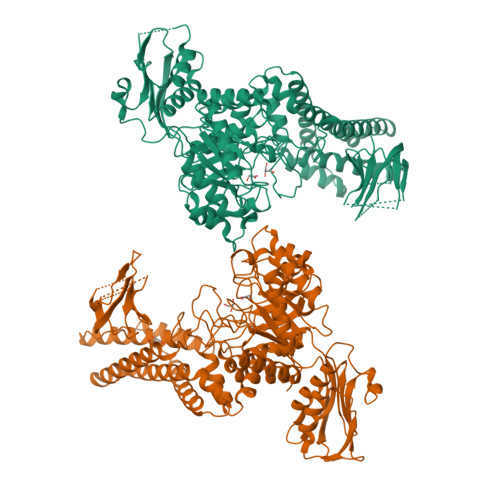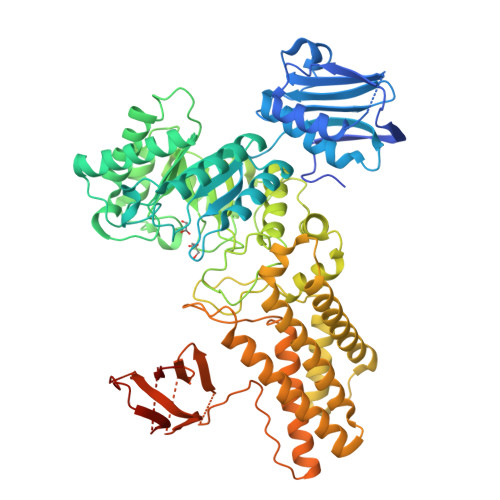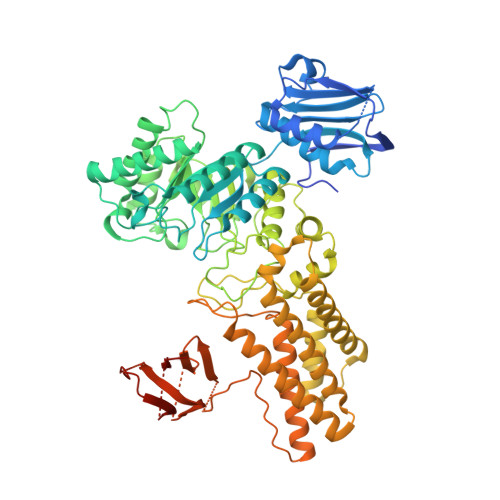Metabolism of Vertebrate Amino Sugars with N-Glycolyl Groups: Intracellular Beta-O-Linked N-Glycolylglucosamine (Glcngc), Udp-Glcngc, and the Biochemical and Structural Rationale for the Substrate Tolerance of Beta-O-Linked Beta-N-Acetylglucosaminidase.
Macauley, M.S., Chan, J., Zandberg, W.F., He, Y., Whitworth, G.E., Stubbs, K.A., Yuzwa, S.A., Bennet, A.J., Varki, A., Davies, G.J., Vocadlo, D.J.(2012) J Biological Chem 287: 28882
- PubMed: 22692202
- DOI: https://doi.org/10.1074/jbc.M112.363721
- Primary Citation of Related Structures:
4AIS, 4AIU - PubMed Abstract:
The O-GlcNAc modification involves the attachment of single β-O-linked N-acetylglucosamine residues to serine and threonine residues of nucleocytoplasmic proteins. Interestingly, previous biochemical and structural studies have shown that O-GlcNAcase (OGA), the enzyme that removes O-GlcNAc from proteins, has an active site pocket that tolerates various N-acyl groups in addition to the N-acetyl group of GlcNAc. The remarkable sequence and structural conservation of residues comprising this pocket suggest functional importance. We hypothesized this pocket enables processing of metabolic variants of O-GlcNAc that could be formed due to inaccuracy within the metabolic machinery of the hexosamine biosynthetic pathway. In the accompanying paper (Bergfeld, A. K., Pearce, O. M., Diaz, S. L., Pham, T., and Varki, A. (2012) J. Biol. Chem. 287, 28865-28881), N-glycolylglucosamine (GlcNGc) was shown to be a catabolite of NeuNGc. Here, we show that the hexosamine salvage pathway can convert GlcNGc to UDP-GlcNGc, which is then used to modify proteins with O-GlcNGc. The kinetics of incorporation and removal of O-GlcNGc in cells occur in a dynamic manner on a time frame similar to that of O-GlcNAc. Enzymatic activity of O-GlcNAcase (OGA) toward a GlcNGc glycoside reveals OGA can process glycolyl-containing substrates fairly efficiently. A bacterial homolog (BtGH84) of OGA, from a human gut symbiont, also processes O-GlcNGc substrates, and the structure of this enzyme bound to a GlcNGc-derived species reveals the molecular basis for tolerance and binding of GlcNGc. Together, these results demonstrate that analogs of GlcNAc, such as GlcNGc, are metabolically viable species and that the conserved active site pocket of OGA likely evolved to enable processing of mis-incorporated analogs of O-GlcNAc and thereby prevent their accumulation. Such plasticity in carbohydrate processing enzymes may be a general feature arising from inaccuracy in hexosamine metabolic pathways.
Organizational Affiliation:
Department of Chemistry, Simon Fraser University, Burnaby, British Columbia V5A 1S6, Canada.





















